Related Research Articles

Elizabeth Garrett Anderson was an English physician and suffragist. She was the first woman to qualify in Britain as a physician and surgeon. She was the co-founder of the first hospital staffed by women, the first dean of a British medical school, the first woman in Britain to be elected to a school board and, as mayor of Aldeburgh, the first female mayor in Britain.
Roger le Poer was a medieval Lord Chancellor from 1135 until 1139 for King Stephen of England. The son of a powerful bishop, Roger owed his position to his family connections. He lost his office when his father and other relatives lost power. Arrested along with his father, Roger was used to secure the surrender of a castle held by his mother and then disappeared from history.

Sophia Louisa Jex-Blake was an English physician, teacher, and feminist. She led the campaign to secure women access to a university education, when six other women and she, collectively known as the Edinburgh Seven, began studying medicine at the University of Edinburgh in 1869. She was the first practising female doctor in Scotland, and one of the first in the wider United Kingdom of Great Britain and Ireland; a leading campaigner for medical education for women, she was involved in founding two medical schools for women, in London and Edinburgh, at a time when no other medical schools were training women.
UCL Medical School is the medical school of University College London (UCL) and is located in London, United Kingdom. The school provides a wide range of undergraduate and postgraduate medical education programmes and also has a medical education research unit and an education consultancy unit. It is internationally renowned and is currently ranked 6th in the world by the QS World University Rankings for Medicine 2023.
The London School of Medicine for Women (LSMW) established in 1874 was the first medical school in Britain to train women as doctors. The patrons, vice-presidents, and members of the committee that supported and helped found the London School of Medicine for Women wanted to provide educated women with the necessary facilities for learning and practicing midwifery and other branches of medicine while also promoting their future employment in the fields of midwifery and other fields of treatment for women and children.

Byzantine medicine encompasses the common medical practices of the Byzantine Empire from c. 400 AD to 1453 AD. Byzantine medicine was notable for building upon the knowledge base developed by its Greco-Roman predecessors. In preserving medical practices from antiquity, Byzantine medicine influenced Islamic medicine and fostered the Western rebirth of medicine during the Renaissance.

Alexander of Lincoln was a medieval English Bishop of Lincoln, a member of an important administrative and ecclesiastical family. He was the nephew of Roger of Salisbury, a Bishop of Salisbury and Chancellor of England under King Henry I, and he was also related to Nigel, Bishop of Ely. Educated at Laon, Alexander served in his uncle's diocese as an archdeacon in the early 1120s. Unlike his relatives, he held no office in the government before his appointment as Bishop of Lincoln in 1123. Alexander became a frequent visitor to King Henry's court after his appointment to the episcopate, often witnessing royal documents, and he served as a royal justice in Lincolnshire.
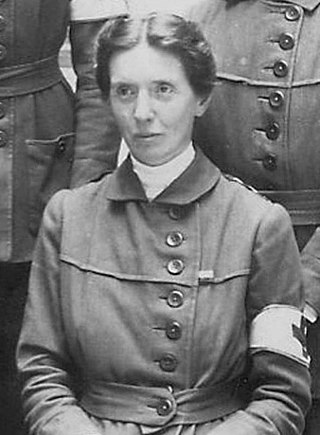
Flora Murray was a Scottish medical pioneer, and a member of the Women's Social and Political Union suffragettes. From 1914 to the end of her life, she lived with her partner and fellow doctor Louisa Garrett Anderson.

Dame Edith Mary Brown, was an English doctor and medical educator. She founded the Christian Medical College Ludhiana in 1894, the first medical training facility for women in Asia, and served as principal of the college for half a century. Brown was a pioneer in the instruction of Indian female doctors and midwives with modern western methods.
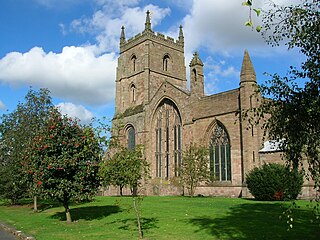
The Priory Church is an Anglican parish church in Leominster, Herefordshire, England, dedicated to Saint Peter and Saint Paul. The building was constructed for a Benedictine Priory in about the 13th century, although there had been an Anglo-Saxon monastery in Leominster, possibly on the same site. In 1539 the east end of the church was destroyed along with most of the monastic buildings, but the main body of the church was preserved.
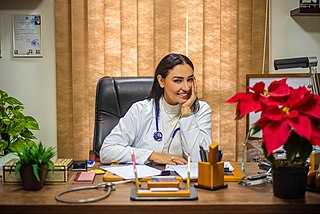
The presence of women in medicine, particularly in the practicing fields of surgery and as physicians, has been traced to the earliest of history. Women have historically had lower participation levels in medical fields compared to men with occupancy rates varying by race, socioeconomic status, and geography.
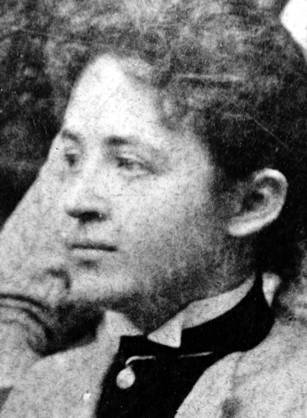
Kate Campbell Hurd-Mead was a pioneering feminist and obstetrician who promoted the role of women in medicine. She wrote A History of Women in Medicine: From the Earliest of Times to the Beginning of the Nineteenth Century in 1938. She was born in Danville, Quebec, Canada, and died in Haddam, Connecticut, United States.

Matilda Charlotte Ayrton was an English physician.
Sibyl de Neufmarché, Countess of Hereford, suo jure Lady of Brecknock, was a Cambro-Norman noblewoman, heiress to one of the most substantial fiefs in the Welsh Marches. The great-granddaughter of Gruffydd ap Llywelyn, king of Wales, Sibyl was also connected to the nobility of England and Normandy. Sibyl inherited the titles and lands of her father, Bernard de Neufmarché, Lord of Brecon, after her mother, Nest ferch Osbern, had declared her brother Mahel to have been illegitimate. Most of these estates passed to Sibyl's husband, Miles de Gloucester, 1st Earl of Hereford, as her dowry. Their marriage had been arranged personally by King Henry I of England in the spring of 1121. Sibyl, with her extensive lands, was central to the King's plans of consolidating Anglo-Norman power in south-east Wales by the merging of her estates with those of Miles, his loyal subject on whom he relied to implement Crown policy.
Margaret of Hereford was an English noblewoman and the eldest daughter of Miles de Gloucester, 1st Earl of Hereford by his wife, the wealthy Cambro-Norman heiress Sibyl de Neufmarché. Margaret married Humphrey II de Bohun, by whom she had five children. Margaret held the office of Constable of England and as a widow, exercised lordship of Herefordshire until her own death. She was the benefactress of several religious institutions.

The Woman's Medical College of Pennsylvania (WMCP) was a Philadelphia medical college founded for women in 1850. It was the second medical institution in the world established to train women in medicine to earn the M.D. degrees after the New England Female Medical College in Boston, which was established two years earlier in 1848.
Emily Bovell was a physician and credited as one of the original members of the Edinburgh Seven. After qualification she worked at the New Hospital for Women in Marylebone Road, London and in Paris. The French government award her the Officier des Ordre des Palmes Académiques for services to medicine. Her husband was the neurologist William Allen Sturge.
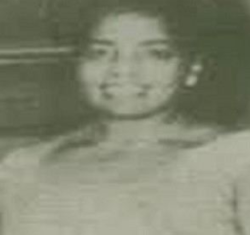
Susan Barbara Gyankorama Ofori-Atta, also de Graft-Johnson, was a Ghanaian medical doctor – the first female doctor on the Gold Coast. She was the first Ghanaian woman and fourth West African woman to earn a university degree. Ofori-Atta was also the third West African woman to become a physician after the Nigerians Agnes Yewande Savage (1929) and Elizabeth Abimbola Awoliyi (1938). In 1933, Sierra Leonean political activist and higher education pioneer, Edna Elliot-Horton became the second West African woman university graduate and the first to earn a bachelor's degree in the liberal arts. Eventually Ofori-Atta became a medical officer-in-charge at the Kumasi Hospital, and later, she assumed in charge of the Princess Louise Hospital for Women. Her contemporary was Matilda J. Clerk, the second Ghanaian woman and fourth West African woman to become a physician, who was also educated at Achimota and Edinburgh. Ofori-Atta was made an Honorary Doctor of Science by the University of Ghana for her work on malnutrition in children, and received the Royal Cross from Pope John Paul II when he visited Ghana in 1980, in recognition of her offering of free medical services at her clinic. She helped to establish the Women's Society for Public Affairs and was a Foundation Fellow of the Ghana Academy of Arts and Sciences. Her achievements were a symbol of inspiration to aspiring women physicians in Ghana.

Mary Almera Parsons was an American physician and activist who successfully petitioned for the Medical Society of the District of Columbia to grant medical licenses to women.
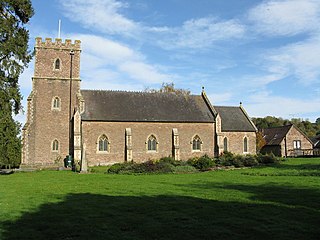
Ford and Stoke Prior is a civil parish in the county of Herefordshire, England, and is 10 miles (16 km) north from the city and county town of Hereford. The closest large town is the market town of Leominster, adjacent at the north-west. The parish includes the hamlet of Ford, the village of Stoke Prior, and the medieval parish churches of St Luke and St John of Jerusalem. At the west of the parish is the site of a Romano-British settlement.
References
- ↑ Kealey, Edward J.; Walton, Michael T. (1985). "Notes and Events: England's Earliest Women Doctors". Journal of the History of Medicine and Allied Sciences. 40 (4): 473–484. doi:10.1093/jhmas/40.4.473. ISSN 0022-5045. JSTOR 24633766. PMID 3905951.
- ↑ Kealey (1985), p. 473.
- ↑ Whaley, L. Women and the Practice of Medical Care in Early Modern Europe, 1400–1800. 2011. p. 20.
- ↑ Kealey (1985), pp. 474–6.
- ↑ Getz, Faye (2004). "Women medical practitioners in England (act. c. 1200–c. 1475), physician" . Oxford Dictionary of National Biography (online ed.). Oxford University Press. doi:10.1093/ref:odnb/54437 . Retrieved 2023-11-29.(Subscription or UK public library membership required.)